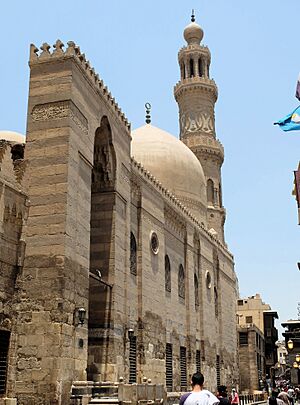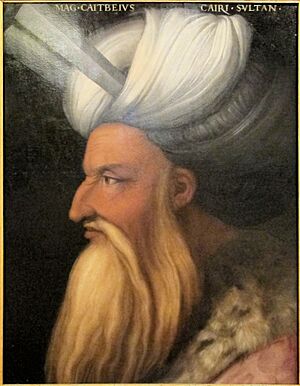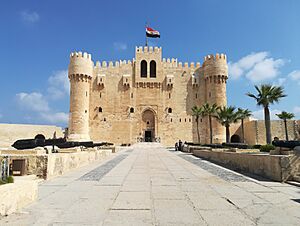Burji Mamluks facts for kids
Quick facts for kids
State of the Circassians
|
|||||||||
|---|---|---|---|---|---|---|---|---|---|
| 1382–1517 | |||||||||
|
Flags according to the Catalan Atlas of c. 1375
|
|||||||||
 |
|||||||||
| Status | Sultanate under the Abbasid Caliphate | ||||||||
| Capital | Cairo | ||||||||
| Spoken languages | Arabic Circassian Turkic |
||||||||
| Religion | Sunni Islam | ||||||||
| History | |||||||||
|
• Established
|
1382 | ||||||||
|
• Disestablished
|
1517 | ||||||||
|
|||||||||
The Burji Mamluks were a group of rulers who led the Mamluk Sultanate of Egypt from 1382 to 1517. They are also known as the Circassian Mamluks. The word "Mamluk" means "owned" or "slave". These rulers were originally bought as slaves, then freed, and rose to powerful positions. The most powerful Mamluks became sultans in Cairo.
Most of the Burji Mamluks came from the Circassians people. They were from the Christian areas of the northern Caucasus mountains. The name Burji means 'of the tower'. This name came from where these Mamluks lived in the Citadel of Cairo.
Sultans often wanted their sons to rule after them. However, these sons rarely stayed in power for long. Strong Mamluk commanders usually took over. These commanders were often Mamluks bought by earlier sultans. Power struggles were common in choosing a new sultan.
During their rule, the Mamluks fought against Timur and took control of Cyprus. But by the 1400s, the sultanate became weaker. This was due to internal fights and money problems. Even though their army was strong, they could not beat the more modern army of the Ottoman Empire. The Ottomans finally conquered them in 1517.
Contents
History of the Burji Mamluks
How the Burji Dynasty Started
Before the Burji Mamluks, Egypt was ruled by the Bahri Mamluks. They were mostly of Turkic origin. In 1377, a rebellion started in Syria and spread to Egypt. Two Circassian leaders, Barakah and Barquq, took control. Barquq became the sultan in 1382. This ended the Bahri dynasty and started the Burji rule.
Barquq was forced out of power in 1389. But he quickly took Cairo back in 1390. He then firmly established the Burji dynasty.
Barquq faced a powerful enemy named Timur. Barquq joined forces with other rulers to resist Timur. However, Barquq died in 1399. In 1401, Timur invaded Syria. He attacked cities like Aleppo and Damascus.
Barquq's son, Sultan Nasir-ad-Din Faraj, got Syria back after Timur died in 1405. But Faraj had many problems with rebellions from his own commanders. He was forced to give up his rule in 1412. After Faraj, an Abbasid caliph ruled for a few months. But soon, another Mamluk, Al-Mu'ayyad Shaykh, became sultan.
Growth and Decline of the Sultanate
Under Sultan Barsbay, the Mamluk Sultanate reached its largest size. In 1426, he invaded the Kingdom of Cyprus. He made its kings become his subjects. However, Barsbay also made some economic choices that hurt the country. For example, he took control of the spice trade. During his time, Egypt's population became much smaller. He often raided areas in Anatolia (modern-day Turkey). Barsbay died in 1438.
Later, Sultan Sayf ad-Din Jaqmaq tried to conquer Rhodes in 1444. But the Knights of St. John stopped his attack.
Sayf ad-Din Inal became sultan in 1453. He had good relations with the Ottoman sultan Mehmed II. Mehmed II captured Constantinople that same year. This was a big event celebrated in Egypt. After this, the relationship between the Ottomans and Mamluks became less friendly. Both empires wanted control of the spice trade. The Ottomans also wanted to control the holy cities of Islam.
Tensions grew under Sultan Sayf ad-Din Khushqadam. He was of Greek origin. Both Khushqadam and Mehmed II supported different leaders in a region called Karaman.
After Mehmed II died in 1481, Sultan Qaitbay angered the Ottoman sultan Bayezid II. Qaitbay gave shelter to Bayezid's rebellious brother. Bayezid II then took some Mamluk lands. But he could not defeat the Mamluks in a long war that ended in 1491. Qaitbay also tried to help Muslims in Spain. He threatened Christians in Syria, but it did not work. He died in 1496, leaving many debts.
After more years of political problems, Al-Ashraf Qansuh al-Ghuri became the last major Mamluk sultan in 1501. He tried to make some changes. He even introduced a military group with gunpowder weapons. But he could not fully add them to the Mamluk army. He also could not fix the country's money problems.
Conquest by the Ottomans
By 1516, the Ottomans were ready to attack the Mamluks. Sultan Selim I had just defeated the Safavid Persians in 1514. He then turned his powerful army towards the Mamluks. The Mamluks still ruled Syria and Egypt. Selim I wanted to complete the Ottoman control of the Middle East.
Al-Ghuri led his army to fight Selim I's invasion of Syria in 1516. But Al-Ghuri died in the Battle of Marj Dabiq. The Mamluk army was completely defeated.
In 1517, the Ottomans finished their conquest. They captured Cairo on January 22. The main center of power moved from Cairo to Constantinople. However, the Mamluks still existed as a political and military group in Ottoman Egypt. Ottoman sultans appointed governors, but Mamluks fought for power within Egypt. They held many important political jobs. They were finally destroyed by Muhammad Ali Pasha in the early 1800s.
List of Burji Sultans
| Titular Name(s) | Personal Name | Reign | |
|---|---|---|---|
| Al-Zahir الظاہر |
Sayf-ad-Din Barquq سیف الدین برقوق |
1382–1389 first reign |
|
| Sultan As-Saleh Al-Muzaffar Al-Mansur سلطان الصالح المظفر المنصور |
Salah-ad-Din Hajji II صلاح الدین حاجی ثانی |
1389 | |
| Al-Zahir الظاہر |
Sayf-ad-Din Barquq سیف الدین برقوق |
1390–1399 second reign |
|
| Al-Nasir الناصر |
Nasir-ad-Din Faraj ناصر الدین فرج |
1399–1405 first reign |
|
| Al-Mansur المنصور |
Izz ad-Din Abd al-Aziz عز الدین عبدالعزیز |
1405 | |
| Al-Nasir الناصر |
Nasir-ad-Din Faraj ناصر الدین فرج |
1405–1412 second reign |
|
| Al-Adil العادل |
Al-Musta'in Billah المستعین باللہ |
1412 | |
| Al-Mu'ayyad المؤید |
Shaykh al-Mahmudi شيخ المحمودى |
1412–1421 | |
| Al-Muzaffar المظفر |
Ahmad أحمد |
1421 | |
| Al-Zahir الظاہر |
Sayf ad-Din Tatar سیف الدین تتر |
1421 | |
| As-Saleh الصالح |
An-Nasir ad-Din Muhammad ناصر الدین محمد |
1421–1422 | |
| Al-Ashraf الأشرف |
Sayf-ad-Din Barsbay سیف الدین برسبای |
1422–1437 | |
| Al-Aziz العزیز |
Jamal-ad-Din Yusuf جمال الدین یوسف |
1437–1438 | |
| Al-Zahir الظاہر |
Sayf ad-Din Jaqmaq سیف الدین جقمق |
1438–1453 | |
| Al-Mansur المنصور |
Fakhr-ad-Din Uthman فخرالدین عثمان |
1453 | |
| Al-Ashraf الأشرف |
Sayf-ad-Din Inal سیف الدین إینال |
1453–1461 | |
| Al-Mu'ayyad المؤید |
Shihab-ad-Din Ahmad شھاب الدین أحمد |
1461 | |
| Al-Zahir الظاہر |
Sayf ad-Din Khushqadam سیف الدین خوش قدم |
1461–1467 | |
| Al-Zahir الظاہر |
Sayf ad-Din Bilbay سیف الدین بلبأی |
1467 | |
| Al-Zahir الظاہر |
Taimur Bugha تیمور بغا |
1467–1468 | |
| Al-Ashraf الأشرف |
Sayf-ad-Din Qait Bay سیف الدین قایتبای |
1468–1496 | |
| Al-Nasir الناصر |
Muhammad bin Qait Bay الناصر محمد بن قایتبای |
1496–1497 first reign |
|
| Al-Zahir الظاہر |
Qansuh Khumsama'ah قانصوه خمسمائة |
1497 | |
| Al-Nasir الناصر |
Muhammad bin Qait Bay الناصر محمد بن قایتبای |
1497–1498 second reign |
|
| Al-Zahir الظاہر |
Qansuh Al-Ashrafi قانصوہ الأشرفی |
1498–1500 | |
| Al-Ashraf الأشرف |
Al-Ashraf Janbalat جنبلاط |
1500–1501 | |
| Al-Adil العادل |
Sayf-ad-Din Tuman Bay I سیف الدین طومان بای |
1501 | |
| Al-Ashraf الأشرف |
Qansuh Al-Ghawri قانصوہ الغوری |
1501–1516 | |
| Al-Ashraf الأشرف |
Tuman Bay II طومان بای |
1516–1517 | |
| The Burji dynasty of the Mamluk Sultanate (Cairo) was taken over by the Ottoman Empire under Sultan Selim I in 1517 C.E. | |||
- The orange row shows a short time when the Bahri dynasty ruled instead of the Burji dynasty.
- The silver row shows a time when the Abbasid dynasty ruled instead of the Burji dynasty.
See also
- History of Arab Egypt
- History of Ottoman Egypt
- List of Sunni Muslim dynasties







